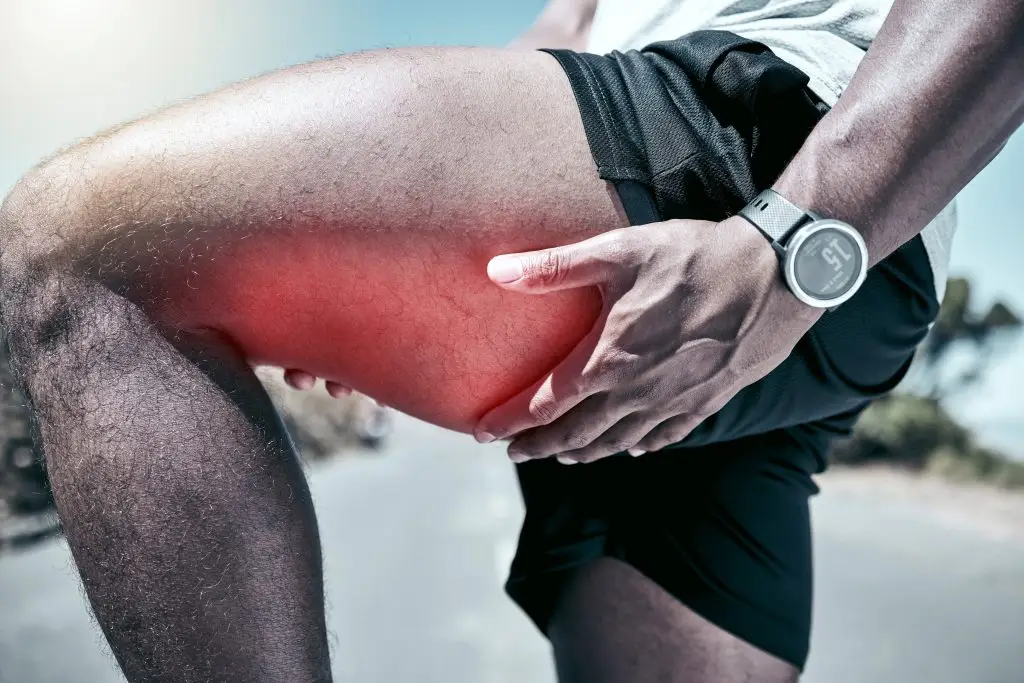Hamstring pain can be a real impairment, whether you’re a competitive athlete forced to sit on the sidelines or someone struggling to get through their daily routine. The sharp, aching pain in the back of your thigh can range from mildly inconvenient to absolutely debilitating, interrupting your lifestyle and keeping you from doing the things you love.
If you’ve pulled a hamstring and can’t find a way to get back to normal, there may still be self-care options to try before starting to seek more professional treatment from a physical therapist.
Causes of hamstring injuries
The hamstrings are a group of three muscles located at the back of each thigh. They play a critical role in allowing you to walk, run, jump, and bend your knees. But due to their constant involvement in nearly every movement you make, they’re also one of the most commonly injured muscle groups.
Athletic activities and sudden movements
Sports that involve sudden stops, starts, and sprints are a leading cause of hamstring injuries. Think soccer, basketball, tennis, or track and field sports. Athletes often strain or tear their hamstrings while trying to accelerate quickly or change direction abruptly.
Non-athletic causes
While athletes are at higher risk, hamstring pain isn’t exclusive to high-exertion activities. Everyday activities or anatomical factors can also lead to issues. These include:
- Hyperextending the muscles during daily tasks
- Poor posture or muscle imbalances
- Lack of flexibility, especially as we age
- Previous injuries that were not fully rehabilitated
- Poor ergonomics in the workplace or during exercise
Whether caused by sports or day-to-day movements, understanding the root cause of your pain is the first step in finding relief.
Symptoms of hamstring injuries
If your first reaction to sudden thigh pain is to clutch the back of your leg, that’s a strong indicator of a hamstring issue. However, the symptoms can vary depending on the severity of the injury. Here’s what else to look out for:
- Sharp pain or discomfort: Usually felt at the back of the thigh during movement or when trying to bear weight.
- Bruising: Visible discoloration on the back of the leg, which often develops within a day or two of the injury.
- Swelling: The injured area may feel tender, swollen, and warm to the touch.
- Difficulty walking: Severe hamstring injuries may leave you unable to put weight on the affected leg without significant discomfort.
- Muscle weakness: A sudden loss of strength in the affected leg.
If you’re noticing any of these signs, it’s important to immediately stop activities and have a medical professional like an athletic trainer or physical therapist evaluate the injury promptly to prevent further damage.
How to treat a pulled hamstring
Hamstring injuries can take weeks or even months to heal, depending on their severity. However, proper care and treatment can speed up the recovery process compared to waiting for the injury to heal on its own.
For low-grade injuries, at-home treatment following the RICE method can be a helpful first step, although to know for sure whether the injury isn’t more severe than you think it is, it’s always a good idea to see a physical therapist for an evaluation.
RICE method
The RICE method is a tried-and-true remedy for minor muscle injuries and can be an effective first step in managing hamstring pain.
- Rest the injured leg to allow healing. Avoid weight-bearing activities or anything that worsens the pain.
- Apply a cold ice pack for 15–20 minutes every few hours to reduce swelling.
- Use compression bandages to stabilize the area and minimize swelling.
- Keep the leg elevated above heart level when possible to reduce fluid build-up and improve circulation.
Physical therapy and rehabilitation
While the RICE method is a great starting point, long-term recovery often requires a more structured approach led by a professional.
Physical therapy after any injury focuses on rebuilding strength, improving flexibility, and restoring full range of motion. A therapist will also tailor treatments to your unique needs, considering factors like age, activity level, and injury history.
For hamstring injuries in particular, caution is needed with doing stretches and bearing weight because doing the wrong thing too soon in recovery can re-injure the area and set you back in your rehabilitation.
Recover from hamstring injuries reliably with Therapydia
At Therapydia, we specialize in helping you get back on your feet and staying injury-free for longer. Whether you’re looking to recover from a minor pull or a more serious hamstring injury, our musculoskeletal rehab experts are here to guide you through every step of the healing process.
During your first appointment, we’ll assess your pain, discuss your goals, and create a personalized treatment plan designed to start healing your hamstring pain effectively. From cutting-edge therapies to tailored exercise programs, we provide all the tools you need for a full recovery.
Learn more about our facilities, treatment process, and how we can help you heal quickly calling a Therapydia clinic near you or by requesting your first appointment online today.

